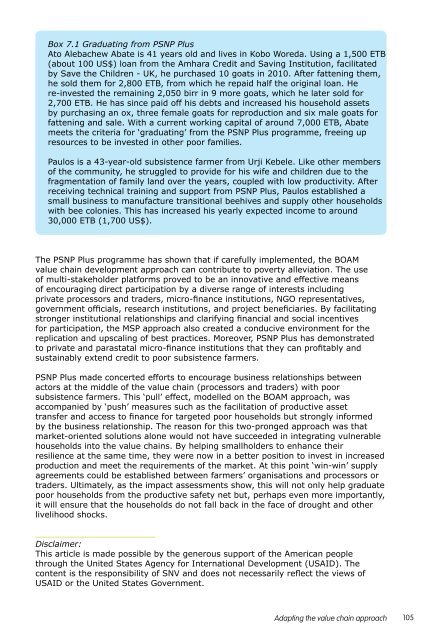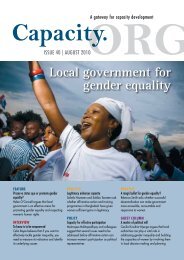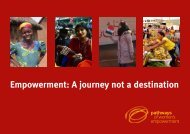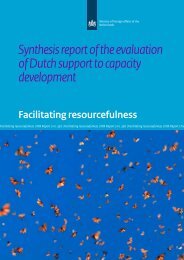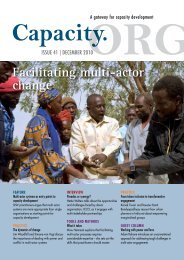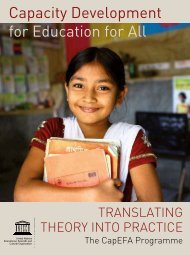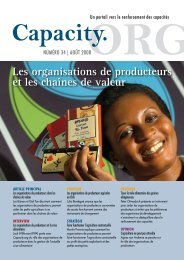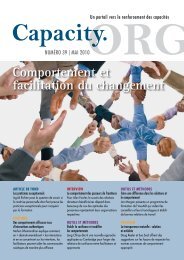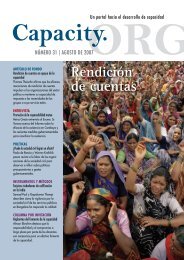Pro-Poor Value Chain Development - Capacity.org
Pro-Poor Value Chain Development - Capacity.org
Pro-Poor Value Chain Development - Capacity.org
You also want an ePaper? Increase the reach of your titles
YUMPU automatically turns print PDFs into web optimized ePapers that Google loves.
Box 7.1 Graduating from PSNP Plus<br />
Ato Alebachew Abate is 41 years old and lives in Kobo Woreda. Using a 1,500 ETB<br />
(about 100 US$) loan from the Amhara Credit and Saving Institution, facilitated<br />
by Save the Children - UK, he purchased 10 goats in 2010. After fattening them,<br />
he sold them for 2,800 ETB, from which he repaid half the original loan. He<br />
re-invested the remaining 2,050 birr in 9 more goats, which he later sold for<br />
2,700 ETB. He has since paid off his debts and increased his household assets<br />
by purchasing an ox, three female goats for reproduction and six male goats for<br />
fattening and sale. With a current working capital of around 7,000 ETB, Abate<br />
meets the criteria for ‘graduating’ from the PSNP Plus programme, freeing up<br />
resources to be invested in other poor families.<br />
Paulos is a 43-year-old subsistence farmer from Urji Kebele. Like other members<br />
of the community, he struggled to provide for his wife and children due to the<br />
fragmentation of family land over the years, coupled with low productivity. After<br />
receiving technical training and support from PSNP Plus, Paulos established a<br />
small business to manufacture transitional beehives and supply other households<br />
with bee colonies. This has increased his yearly expected income to around<br />
30,000 ETB (1,700 US$).<br />
The PSNP Plus programme has shown that if carefully implemented, the BOAM<br />
value chain development approach can contribute to poverty alleviation. The use<br />
of multi-stakeholder platforms proved to be an innovative and effective means<br />
of encouraging direct participation by a diverse range of interests including<br />
private processors and traders, micro-finance institutions, NGO representatives,<br />
government officials, research institutions, and project beneficiaries. By facilitating<br />
stronger institutional relationships and clarifying financial and social incentives<br />
for participation, the MSP approach also created a conducive environment for the<br />
replication and upscaling of best practices. Moreover, PSNP Plus has demonstrated<br />
to private and parastatal micro-finance institutions that they can profitably and<br />
sustainably extend credit to poor subsistence farmers.<br />
PSNP Plus made concerted efforts to encourage business relationships between<br />
actors at the middle of the value chain (processors and traders) with poor<br />
subsistence farmers. This ‘pull’ effect, modelled on the BOAM approach, was<br />
accompanied by ‘push’ measures such as the facilitation of productive asset<br />
transfer and access to finance for targeted poor households but strongly informed<br />
by the business relationship. The reason for this two-pronged approach was that<br />
market-oriented solutions alone would not have succeeded in integrating vulnerable<br />
households into the value chains. By helping smallholders to enhance their<br />
resilience at the same time, they were now in a better position to invest in increased<br />
production and meet the requirements of the market. At this point ‘win-win’ supply<br />
agreements could be established between farmers’ <strong>org</strong>anisations and processors or<br />
traders. Ultimately, as the impact assessments show, this will not only help graduate<br />
poor households from the productive safety net but, perhaps even more importantly,<br />
it will ensure that the households do not fall back in the face of drought and other<br />
livelihood shocks.<br />
Disclaimer:<br />
This article is made possible by the generous support of the American people<br />
through the United States Agency for International <strong>Development</strong> (USAID). The<br />
content is the responsibility of SNV and does not necessarily reflect the views of<br />
USAID or the United States Government.<br />
Adapting the value chain approach<br />
105


